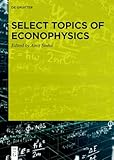Select Topics of Econophysics / ed. by Amit Sinha.
Material type: TextPublisher: Berlin ; Boston : De Gruyter, [2024]Copyright date: 2025Description: 1 online resource (XVI, 467 p.)Content type:
TextPublisher: Berlin ; Boston : De Gruyter, [2024]Copyright date: 2025Description: 1 online resource (XVI, 467 p.)Content type: - 9783110998788
- 9783110987652
- 9783110987584
- online - DeGruyter
- Issued also in print.
| Item type | Current library | Call number | URL | Status | Notes | Barcode | |
|---|---|---|---|---|---|---|---|
 eBook
eBook
|
Biblioteca "Angelicum" Pont. Univ. S.Tommaso d'Aquino Nuvola online | online - DeGruyter (Browse shelf(Opens below)) | Online access | Not for loan (Accesso limitato) | Accesso per gli utenti autorizzati / Access for authorized users | (dgr)9783110987584 |
Frontmatter -- Contents -- Foreword -- Chapter 1 Econophysics: An Introduction -- Chapter 2 Logistic Modelling of Economic Dynamics -- Chapter 3 Outlook About the Mathematical Foundation of Creativity in Economy: Monadic Approach and Holistic Role of the Zeta Riemann Function -- Chapter 4 The Visualization of the U.S. Economy Under the Application of the EGAP-Helix -- Chapter 5 Wealth Distribution Patterns in Different Socio-economic Environments: Data Mining, Estimation and Modelling -- Chapter 6 Kinetic Exchange Models of Income and Wealth Distribution: Self Organization and Poverty Level -- Chapter 7 Kinetic Monte Carlo Simulations of an Agent-Based Model of Market Dynamics -- Chapter 8 Quantifying Economic Dynamics: Unveiling the Formula for Monetary Energy (Em) -- Chapter 9 Sociophysics Model of Bubbles with Neural-Stochastic Differential Equations: A Stochastic Inflation Model -- Chapter 10 Criticality of the Bitcoin Market -- Chapter 11 Decoding Cryptocurrency Vulnerability: Assessing Risk and Factors -- Chapter 12 A Quasi-optimal Technique for Rebalancing a Cryptocurrency Wallet -- Chapter 13 Price Modelling under Generalized Fractional Brownian Motion -- Chapter 14 Simplifying to Improve Reliability of Geometric Brownian Motion Stock Index Forecasts -- Chapter 15 Do Economic and Financial Factors Affect Expected S&P 500? -- Chapter 16 Predictability of Technical Analysis -- Chapter 17 Fractal Regressions: An Econophysics Innovation to Apply in Economics and Finance -- Chapter 18 The Menace and Caress of Wave: The Econophysics of Informational Diffusion -- Chapter 19 Improving Chaos Control: Implications for Economic Policies -- Chapter 20 Of Time and the River: Comovement, Heterogeneity, and Multifractality in a World Lit by Lightning -- Chapter 21 Transfer Entropies between Market Stocks -- Chapter 22 Multifractal Analysis of Regimes in Financial Markets -- Chapter 23 Evidence of Chaos in the Moroccan Stock Market before and during the Covid-19 Pandemic -- Chapter 24 Complexity Measure, Kernel Density Estimation, Bandwidth Selection, and the Efficient Market Hypothesis -- Chapter 25 Exploring the Intersection of Chemistry and Economic: The Emergence of Econochemistry -- Chapter 26 Developing a 3D Printed Prototype for Visualizing Large Development Indicator Performance in Any Country: The Domestic Development Domestic Integrated Structures (DDGIS) -- Acknowledgements -- List of Contributors -- List of Figures -- List of Tables -- About the Editor -- Index
restricted access online access with authorization star
http://purl.org/coar/access_right/c_16ec
Economics requires understanding and analyzing forces that bring buyers and sellers to a market place who then negotiate exchanges of goods and services based on a mutually agreeable price. Economists have their own method of modeling whereby models are first conceived of some notion of economic and financial thinking, before being empirically tested, and anomalies are then recognized if the observed data is inconsistent with the hypothetical underpinning. This is in inherent contradiction with the modeling approaches of physicists who develop their theories, principle and laws after observing empirical data. The awareness that physics can enlighten the understanding of human behavior (and thus economics), and the interest of physicists in applying their training and models to understanding the complexities of finance and economics, led to the creation of a new field of study appropriately termed as Econophysics. Selected Topics on Econophysics is a collection of essays on topics that enhance and enrich our understanding of economic modeling when the same rigor of modelling used by physicists is brought to developing financial and economic theories. These articles include discussions on modeling bitcoins, stock index modeling using geometric Brownian motion, agent-based modeling, wealth distribution modeling, as well as modeling related to fractal regression, and chaotic processes. This interdisciplinary book will interest researchers, graduate students and professionals in the fields of economics, finance as well as physics.
Issued also in print.
Mode of access: Internet via World Wide Web.
In English.
Description based on online resource; title from PDF title page (publisher's Web site, viewed 20. Nov 2024)


